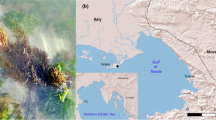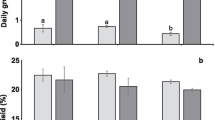Abstract
Commercial farming of the intertidal brown alga Hizikia fusiformis (Harvey) Okamura in China and South Korea in the sea depends on three sources of seedlings: holdfast-derived regenerated seedlings, young plants from wild population and zygote-derived seedlings. Like many successfully farmed seaweed species, the sustainable development of Hizikia farming will rely on a stable supply of artificial seedlings via sexual reproduction under controlled conditions. However, the high rate of detachment of seedlings after transfer to open sea is one of the main obstacles, and has limited large-scale application of zygote-derived seedlings. To seek the optimal condition for growing seedlings on substratum in land-based tanks for avoidance of detachment in this investigation, young seedlings were grown in both outdoor tanks exposed directly to sunlight and in indoor raceway tanks in reduced, filtered sunlight. Results showed that young seedlings, immediately after fertilization, could withstand a daily fluctuation of direct solar irradiance up to a level of 1800 μmol photons m−2 s−1, and maintained a faster growth rate than seedlings grown in indoor tanks. Detailed experiments by use of chlorophyll fluorescence measurements further demonstrated that the overnight (12 h) recovery of optimal fluorescence quantum yield (Fv/Fm) of seedlings after 1 h treatment at 40°C was 98%, and the 48 h recovery of Fv/Fm of seedlings after 1 h exposure to 1800 μmol m−2 s−1 was 92%. Forty-one-day-old seedlings showed no significant decrease of optimal fluorescence quantum yield at salinity ranging from 30 to 5 ppt for a treatment up to 17 h. Six-hour desiccation treatment did not have any influence on the optimal fluorescence quantum yield. Exposure to 18 mmol L−1 sodium hypochlorite for 10 min did not damage the PSII efficiency, and thus could be used to remove epiphytic algae. The strong tolerance of young seedlings to high temperature, high irradiance, low salinity and desiccation found in this investigation supports the view that mass production of Hizikia seedlings should be performed in ambient light and temperature instead of in shaded greenhouse tanks.







Similar content being viewed by others
References
Adams III WW, Demmig-Adams B (2004) Chlorophyll fluorescence as a tool to monitor plant response to the environment. In: George C. Papageorgiou and Govindjee (eds) Advances in photosynthesis and respiration, vol. 19. Chlorophyll a fluorescence: a signature of photosynthesis. Springer, Berlin, p 598
Bazes A, Silkina A, Defer D, Berné de-Bauduin C, Quéméner E, Braud J-P, Bourgougnon N (2006) Active substances from Ceramium botryocarpum used as antifouling products in aquaculture. Aquaculture (in press)
Davison IR, Pearson GA (1996) Stress tolerance in intertidal seaweeds. J Phycol 32:197–211
Hanelt D (1996) Photoinhibition of photosynthesis in marine macroalgae. Sci Mar 60(Suppl. 1):243–248
Hanelt D, Wiencke C, Karsten U (1997) Photoinhibition and recovery after high light stress in different developmental and life-history stages of Laminaria saccharina (Phaeophyta). J Phycol 33:387–395
Hwang EK, Cho YC, Sohn CH (1999) Reuse of holdfasts in Hizikia fusiformis cultivation. J Korean Fish Sci 32:112–116 (in Korean with English abstract)
Larkindale J, Hall JD, Knight MR, Vierling E (2005) Heat stress phenotypes of Arabidopsis mutants implicate multiple signaling pathways in the acquisition of thermotolerance. Plant Physiol 138:882–897
Pang SJ, Fei XG, Xiao T, Wang JC (2001) Mass production of the artificial seeds of Hizikia fusiformis by controlling egg release and fertilization. Mar Sci 25:53–54 (In Chinese with English abstract)
Pang SJ, Chen LT, Zhuang DG, Fei XG, Sun JZ (2005) Cultivation of the brown alga Hizikia fusiformis (Harvey) Okamura: enhanced seedling production in tumbled culture. Aquaculture 245:321–329
Pang SJ, Gao SQ, Sun JZ (2006) Cultivation of the brown alga Hizikia fusiformis (Harvey) Okamura: controlled fertilization and early development of seedlings in raceway tanks in ambient light and temperature. J Appl Phycol 18:723-731
Sagert S, Schubert H (2000) Acclimation of Palmaria palmata (Rhodophyta) to light intensity: comparison between artificial and natural light fields. J Phycol 36:1119–1128
Schreiber U (2004) Pulse-Amplitude-Modulation (PAM) fluorometry and saturation pulse method: an overview. In: George C. Papageorgiou and Govindjee (Eds) Advances in photosynthesis and respiration, vol. 19. Chlorophyll a fluorescence: a signature of photosynthesis. Springer, Berlin
Schreiber U, Bilger W (1987) Rapid assessment of stress effects on plant leaves by chlorophyll fluorescence measurements. In: Tenhunen JD, Catarino FM, Lange OL, Oechel WC (eds) Plant response to stress. Springer, Berlin, pp 27–53
ShiDao Seaweed Seedling Rearing Station (1988) Primary study on the artificial seedling rearing of Sargassum fusiforme (Harv.). Setchaku Trans Oceanol Limnol 2:82–85 (in Chinese with English abstract)
Starr R, Zeikus JA (1987) UTEX-the culture collection of algae at the University of Texas at Austin. J Phycol 23(Suppl.):1–47
Sun JZ, Fang JZ, Zhu ZF (1996) A preliminary study on the reproductive biology of Sargassum fursiforme. J Zhejiang Coll Fish 15:243–249 (in Chinese with English abstract)
Zou DH, Gao KS (2005a) Regulation of gamete release in the economic brown seaweed Hizikia fusiforme (Phaeophyta). Biotech Lett 27:915–918
Zou DH, Gao KS (2005b) Photosynthetic characteristics of the economic brown seaweed Hizikia fusiforme (Sargassaceae, Phaeophyta), with special reference to its “leaf” and receptacle. J Appl Phycol 17:255–259
Zou DH, Gao KS, Run ZX (2006) Seasonal pattern of reproduction of Hizikia fusiformis (Sargassaceae, Phaeophyta) from Nanao Island, Shantou, China. J Appl Phycol 18:195–201
Acknowledgements
The authors wish to thank S.Q. Gao for maintaining the algal culture during the experiment in the laboratory and several workers to manage the collectors in outdoor tanks. This research is supported by the 863 Hi-Tech Research and Development Program of China (Nr.: 2004AA603310) and the Natural Science Foundation of China (NSFC. Nr.: 30471327).
Author information
Authors and Affiliations
Corresponding author
Rights and permissions
About this article
Cite this article
Pang, S.J., Zhang, Z.H., Zhao, H.J. et al. Cultivation of the brown alga Hizikia fusiformis (Harvey) Okamura: stress resistance of artificially raised young seedlings revealed by chlorophyll fluorescence measurement. J Appl Phycol 19, 557–565 (2007). https://doi.org/10.1007/s10811-007-9170-y
Received:
Accepted:
Published:
Issue Date:
DOI: https://doi.org/10.1007/s10811-007-9170-y




